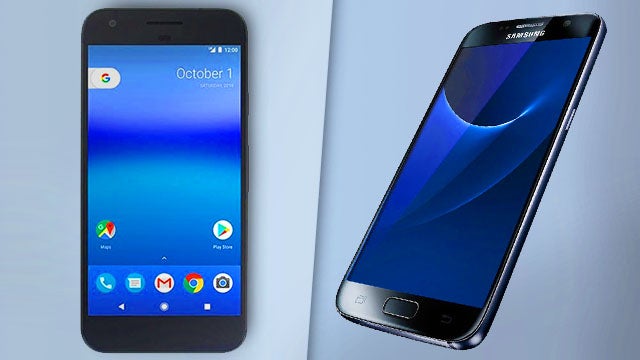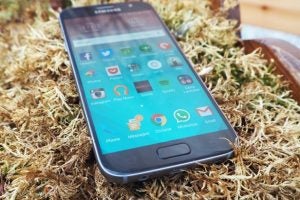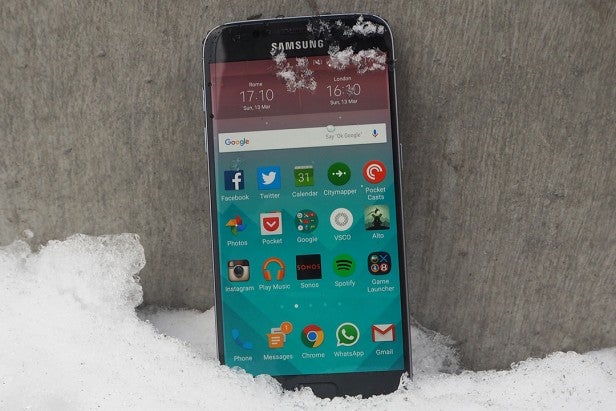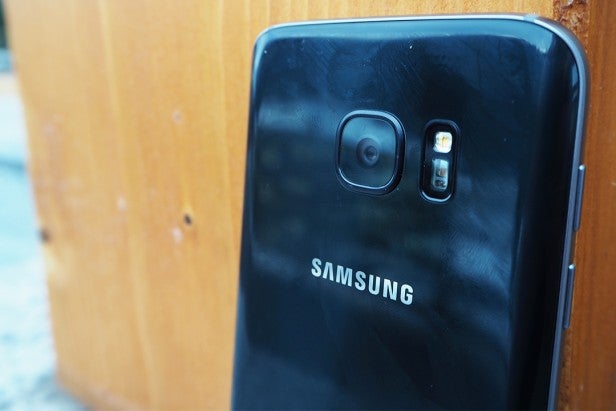Google Pixel vs Samsung Galaxy S7: Which phone is best?

Samsung Galaxy S7 vs Google Pixel: The ultimate Android head-to-head pits Samsung against Google. Who wins?
None can deny that Samsung’s Galaxy S7 is a truly incredible handset. We gave it a five-star review, and with good reason. It’s attractive, powerful, and takes fantastic photos. Considering Apple’s poor show with the iPhone 7, and the Galaxy Note 7 recall fiasco, the Galaxy S7 is arguably the best phone on the market.
But there’s a new contender: the Google Pixel. Google’s flagship handset for the next 12 months, the Pixel packs some seriously impressive hardware. Google wants the Pixel to showcase just how great Android can be – but does it reach the Samsung Galaxy S7’s lofty heights?
Here’s our guide to the differences between the Galaxy S7 and the Google Pixel.
Get Deal: Galaxy S7 Edge – just £369.99 from Amazon
Watch: Google’s Pixel phone event in just 3 minutes
Related: Google Pixel vs Pixel XL
Galaxy S7 vs Google Pixel – Design
Galaxy S7: 142 x 70 x 7.9mm | 152g | Corning Gorilla Glass 4 | IP68 water-resistant | Black, White, Gold, Silver, Pink Gold
Google Pixel: 143.84 x 69.54 x 7.31mm | 143g | Corning Gorilla Glass 4 | IP53 splash-resistant| Black, Silver, Blue
Samsung’s Galaxy S7 is super-attractive, and is available in a range of colours: Black, White, Gold, Silver, and Pink Gold. It’s slim at 7.9mm, and reasonably light for a metal phone at 152g. Both the back and screen are protected by Corning’s Gorilla Glass 4 – although anecdotal evidence suggests this isn’t foolproof. (Editor’s note: He means he’s dropped his and cracked it on both sides, the dolt.)
- Buy now: Samsung Galaxy S7 on EE (5GB) for £27/month
- Buy now: Samsung Galaxy S7 on Vodafone (16GB) for £36/month
Related: Google Pixel vs Note 7

One of the best features about the Galaxy S7 is its waterproof chassis. It’s IP68-certified, which means it can withstand being submerged in water at a depth of 1.5m for up to 30 minutes. Unfortunately, it turns out that Google’s Pixel phone is only IP53-certified – that’s splashproof at best, so don’t dunk it.
On the bright side, the Google Pixel handsets are very attractive, if a little prosaic. You’re getting a standard rectangular build with rounded edges, and a fingerprint scanner on the back; that’s in contrast to the S7’s fingerprint sensor, which is embedded in the home button on the front. The metal and glass Google Pixel phones both feature antenna designs on the rear, as well as a half-matte, half-glossy finish that has proved divisive in the office, but has earned the approval of our Mobile Editor Max Parker.
Galaxy S7 vs Google Pixel – Display
Galaxy S7: 5.1-inch screen | 1,440 x 2,560 pixels | 577ppi pixel density | 72.1% screen-to-body ratio | Super AMOLED
Google Pixel: 5-inch screen | 1,080 x 1,920 pixels | 424ppi pixel density | 69% screen-to-body ratio | AMOLED
The Galaxy S7 display is averagely sized at 5.1 inches. Where the S7 shines is with its QHD panel (that’s 1,440 x 2,560 pixels), which provides a huge 577ppi pixel density. That means the screen always looks sharp, no matter how close you hold it to your face. This is important, because when docking the phone in a Gear VR headset, those extra pixels make all the difference to your virtual-reality experience.
Get Deal: Galaxy S7 Edge – just £369.99 from Amazon
Related: Google Pixel vs iPhone 7
![]()
It’s also worth noting that Samsung uses its own custom-built Super AMOLED displays on the Galaxy S7. OLED simply means that the pixels on the display produce their own light, rather than relying on a backlight. This saves energy, because individual pixels can be turned on or off when needed. It also means you’ll see truer blacks compared to a conventional LCD screen, because a pixel that’s turned off emits zero light.
Finally, Samsung has kitted out its display with an “always-on” mode that displays the time and date, plus important notifications. Battery drain is minimal at about 1% per hour, and it can be toggled off if you don’t like it.
All in all, the Galaxy S7 features a sharp and vibrant display that performs well when docked in a VR headset.

The Google Pixel sports a 5-inch AMOLED display, which is a little smaller than the Galaxy S7, though only just. It’s also lower resolution, with 1,080 x 1,920 pixels – that makes Samsung a winner. However, the larger Google Pixel XL features a 5.5-inch QHD display, which is more on par with the S7. In any case, there’s not much in the way of fancy features (like the S7’s always-on screen) with the Pixel display.
- Buy now: Samsung Galaxy S7 on EE (5GB) for £27/month
- Buy now: Samsung Galaxy S7 on Vodafone (16GB) for £36/month
Galaxy S7 vs Google Pixel – Hardware
Galaxy S7: Qualcomm Snapdragon 820 (quad-core 2.15GHz) or Exynos 8890 (octa-core 2.3GHz) CPU | Adreno 530 or Mali-T880 GPU | 4GB RAM | 32/64GB storage | microSD slot | Fingerprint scanner | Micro USB
Google Pixel: Qualcomm Snapdragon 821 (quad-core 2.15GHz) | Adreno 530 | 4GB RAM | 32128GB storage | Fingerprint scanner | USB Type C
Samsung has equipped the Galaxy with two different chips, depending on your location. If you’re in the UK, your phone probably has an Exynos 8890 – Samsung’s custom-built chip featuring eight cores. If you’re in the US, you’ll have the similarly powerful Snapdragon 820, built by chip-making giant Qualcomm. It has four cores, but that doesn’t mean it’s any worse in terms of performance. Both chips are built using a 14nm FinFET process, which is very efficient. Expect excellent battery life as a result.
![]()
The rest of the Galaxy S7’s hardware is on point too. For instance, you’re getting 4GB of RAM, 32/64GB storage options, and a microSD slot. With a fingerprint scanner bundled in, too, you’ll want for little else.
The Google Pixel should at least as impressive as the Galaxy S7, featuring the more capable Snapdragon 821 chip, a newer spin-off chip that’s 10% faster than its predecessor. Both phones also feature 4GB of RAM, so hardware should be no problem for the Pixel. You also get a fingerprint scanner, which Google is dubbing ‘Pixel Imprint’. We’ve no idea why.
All that remains is to get Google Pixel benchmarks in, so we can work out which phone is more powerful.
Related: Samsung Galaxy S8
Galaxy S7 vs Google Pixel – Software
Galaxy S7: Android 6.0.1 Marshmallow (with TouchWiz overlay)
Google Pixel: Android 7.1 Nougat (with Pixel Launcher)
The Samsung Galaxy S7 currently runs on Android 6.0.1 Marshmallow, which was launched back in 2015. It introduced a number of new features, including contextual search for Google Now, native fingerprint recognition, support for USB Type-C, and a “Doze” battery-saving mode.
The Google Pixel, however, runs on this year’s Android Nougat – which is even better than Marshmallow. Perhaps the most notable improvement is the addition of split-screen mode. However, Samsung already offers such a feature on the Galaxy S7, courtesy of its TouchWiz overlay. Other perks include notification tacking, a flatter “material design” aesthetic, and additional battery life improvements.
![]()
The only feature that Galaxy S7 owners may be sorry to miss out on is Daydream, Google’s new VR platform. It’s built into Nougat, and requires specific hardware to run – and the Galaxy S7 simply isn’t Daydream-ready.
Overall, Nougat isn’t vastly different from Marshmallow, but key features such as Daydream make it a worthy upgrade. While the Galaxy S7 will eventually get Nougat – probably next year – Google has the upper hand here.
And lest we forget, Pixel also features the Google Assistant digital helper, a well-equipped rival to Apple’s Siri and Amazon’s Alexa. Long-press on the slightly refreshed middle soft key and Google Assistant pops up. Like Now on Tap, it’ll scan your screen for relevant contextual information – bringing up times and cinema information if you’re talking about seeing a film, for instance – but you can now talk directly to it. Ask it for the weather, to set an alarm, or show you directions to work and it’ll spew out an answer much faster than Apple’s Siri.
It also does a much better job at understanding me than Siri, letting me speak in my usual mumbled tones without throwing up a blank screen. Like Siri in iOS 10, the Google Assistant can perform tasks in specific apps. Ask it to play a song in Spotify and it’ll oblige, not forcing you into Google’s own Play Music app. The conversational aspect really stands out; if you’ve asked for the weather, you can follow it up with ‘how about next week’ and it’ll intelligently understand you’re still talking about the weather.
Galaxy S7 vs Google Pixel – Camera
Galaxy S7: Primary: 12-megapixel Dual Pixel | f/1.7 | 26mm | 1/2.5-inch sensor | 1.4um pixel size | Phase Detection Autofocus | OIS | LED flash; Secondary: 5-megapixel | f/1.7 | 22mm | Auto HDR
Google Pixel: Primary: 12-megapixel | f/2.0 | 1.55um pixel size | Phase Detection Autofocus; Secondary: 8-megapixel | f/2.4 | 1.4um pixel size
The Galaxy S7 camera is widely regarded as one of the best in the smartphone market. It’s innovative, and offers up excellent real-world performance – even better than the acclaimed Galaxy S6. That might appear odd at first, since Samsung actually reduced the pixel count from 16 megapixels in the S6 to 12 megapixels in the S7 – but the Galaxy S7 has a trick up its sleeve.

The Galaxy S7 features “Dual Pixel” technology – every pixel on the image sensor has two photodiodes instead of one. The biggest advantage of this increased pixel count is faster focusing. For comparison, when you’re taking a photo with an iPhone, around 5-10% of the pixels are used for focusing. With the Galaxy S7, every single pixel is able to take part. The Galaxy S7 also features a large f/1.7 lens aperture and a 1/2.6-inch sensor.
The Google Pixel also features a 12-megapixel camera, although it’s not clear whether it will be on par with the Galaxy S7’s. After all, the aperture is more narrow. But on the plus side, you’re getting a more substantial 8-megapixel front-facing camera.
Unfortunately, we won’t know whether the Google Pixel can trump the Galaxy S7 until we get a full review of the former.
Related: Best Android Apps 2016
Galaxy S7 vs Google Pixel – Battery
Galaxy S7: 3,000mAh | Non-removable | Fast-charging – 60% in 30 minutes (Quick Charge 2.0) | Wireless charging | Talk time – 22 hours | Music playback – 62 hours
Google Pixel: 2,770mAh| Non-removable | Fast charging – 7 hours in 15 minutes | Talk time – 26 hours | Music playback – 110 hours
The Samsung Galaxy S7 has a sizeable 3,000mAh battery that can’t be removed. Samsung reckons this will get you 22 hours of talk time, or 62 hours of music playback. In reality, daily use tends to leave the phone with about 10-15% of battery life remaining by the end of the day. But the built-in Doze feature means you’ll only lose 3-4% overnight when the phone’s unplugged. There are also a bunch of power-saving modes from which to choose.
![]()
There are two further perks from the Galaxy S7. The first is fast-charging, based on Qualcomm’s Quick Charge 2.0 technology. This lets you hit 60% charge in just 30 minutes – and hit full-charge in just over an hour. Plus there’s Qi/PMA wireless charging, which is by no means a must-have, but it’s definitely a great additional feature.
The Google Pixel runs on a 2,770mAh cell, which is smaller than the one in the Galaxy S7. That said, it’s very likely that battery life won’t be worse than the S7 on account of the Pixel’s lower resolution screen, especially considering the fact that they use the same chip. And don’t forget that the Google Pixel uses newer software designed specifically for the hardware. All this suggests we’ll see impressive longevity from the Pixel. The larger Pixel XL uses a 3,450 mAh battery, so we’re hoping for similarly solid battery performance.
Stay tuned for our Pixel review to get a full verdict on battery life, however.
Get Deal: Galaxy S7 Edge – just £369.99 from Amazon
Related: Best Samsung S7 deals
Galaxy S7 vs Google Pixel – Price
Galaxy S7: £460 | $549
Google Pixel: starting at £599 | $649
The Galaxy S7 cost well over £500 at launch (and still does for some models), but you can pick up the 32GB model for £460 on Amazon. That’s a good price for such a high-quality phone, especially considering it isn’t particularly old.
- Buy now: Samsung Galaxy S7 on EE (5GB) for £27/month
- Buy now: Samsung Galaxy S7 on Vodafone (16GB) for £36/month
The Pixel phone is available to pre-order now in the US and UK. The Pixel will be £599 (32GB) and £699 (128GB) with the Pixel XL coming in at £719 (32 GB) and £819 (128GB). The phone will actually release on October 20.
Galaxy S7 vs Google Pixel – First Impressions
The Samsung Galaxy S7 is a heavy hitter, and yet it doesn’t break the bank. With top-of-the-range specs, a gorgeous design, and impressive real-world performance, the Galaxy S7 is hard to fault. If you’re going to buy this phone today, you certainly won’t be disappointed.
But the Pixel has similar hardware, a newer operating system, and an attractive (though admittedly uninspiring) design.
Until we’ve given the Pixel a full review, we can’t say for sure which phone is the best. But it’s clear this will be a close call, and that if you’re an Android fan, you’ll probably be happy with either handset.
Get Deal: Galaxy S7 Edge – just £369.99 from Amazon
Related: iPhone 8
Watch: Samsung Galaxy S7 review
Which do you prefer: the Google Pixel or the Galaxy S7? Let us know in the comments.


